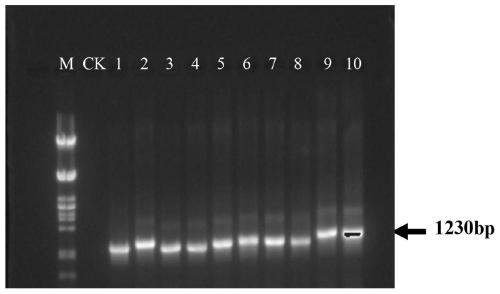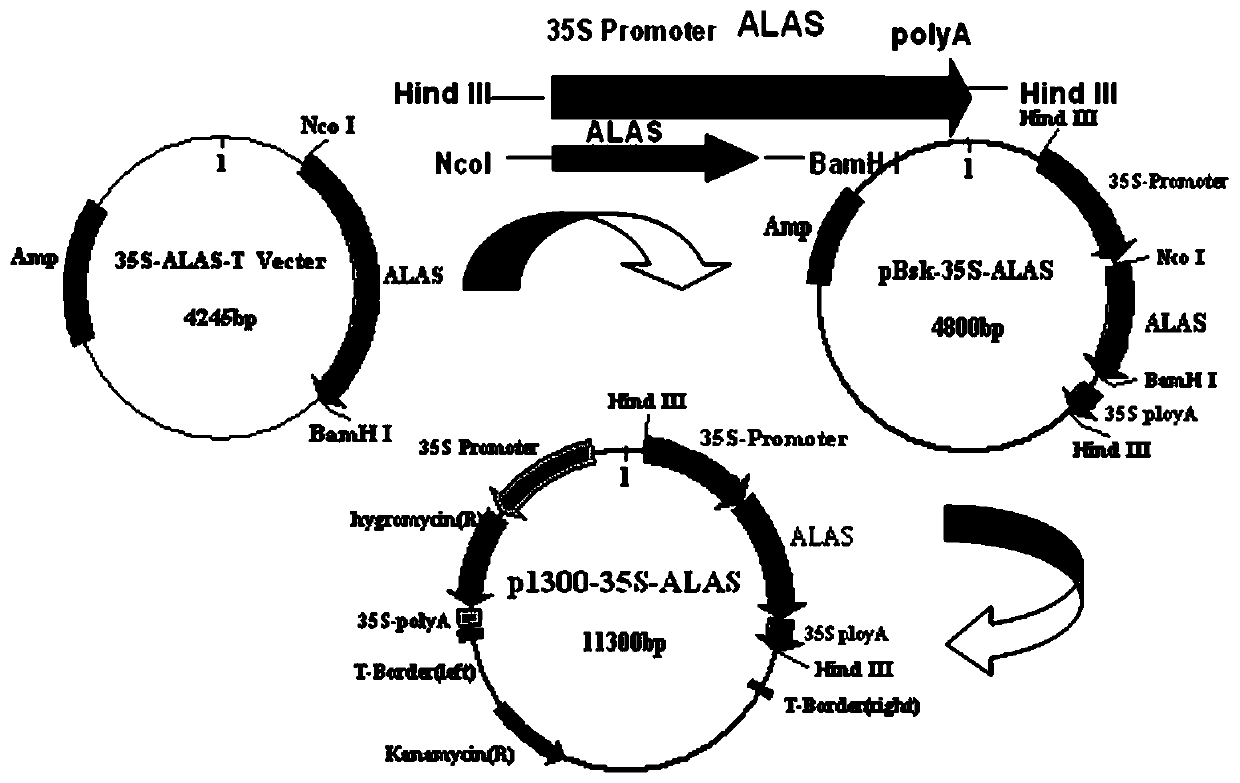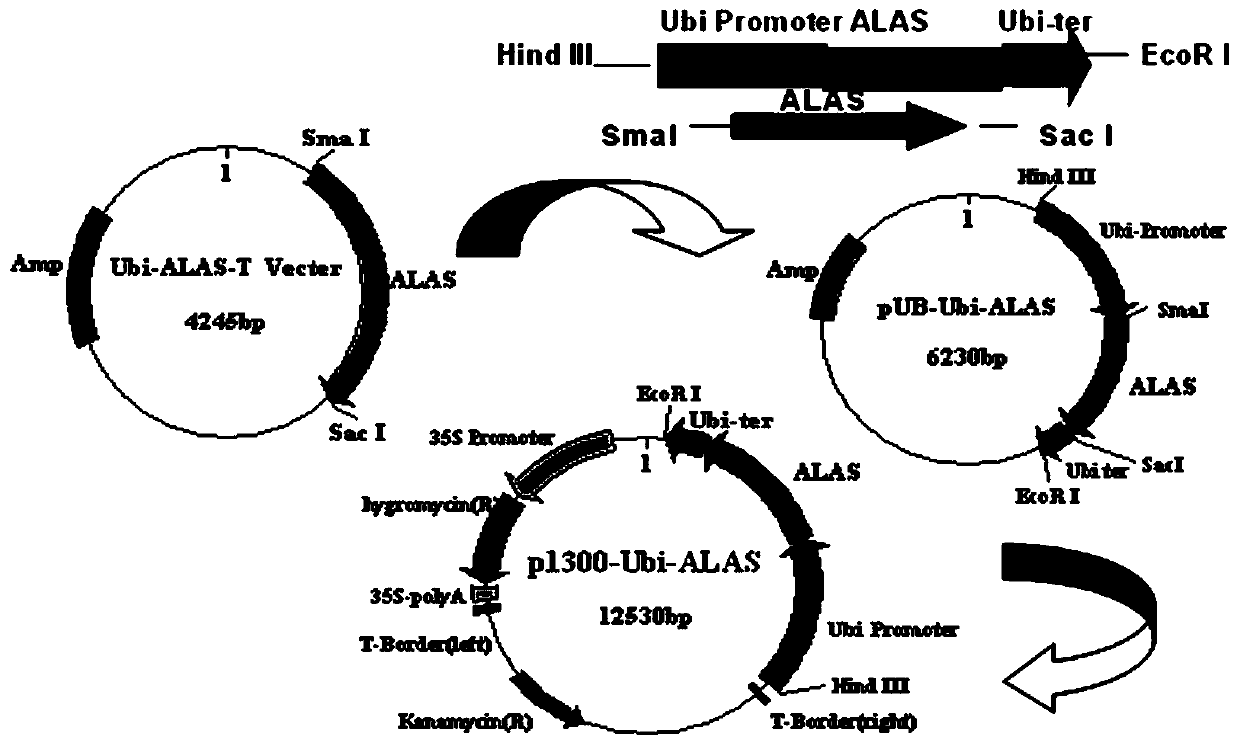Method for improving the low-temperature stress resistance of rice and plant expression vector used in method
A technology of low temperature resistance and high ability, applied in the field of methods and plant expression vectors, can solve the problems of complex resistance genes, limited practical applications, and unsatisfactory resistance levels, and achieve the effect of improving low temperature resistance
- Summary
- Abstract
- Description
- Claims
- Application Information
AI Technical Summary
Problems solved by technology
Method used
Image
Examples
Embodiment 1
[0031] Cloning of embodiment 1, 5-aminolevulinic acid synthase gene
[0032] 1) According to the sequence registration information in NCBI, design 5-ALAS gene-specific PCR amplification primers and introduce enzyme cutting sites. The primer sequences are as follows:
[0033] 5' primer: 5'-CCATGGATGGATTACACCAAGTTCTTC-3' italic part is the NcoI restriction site (for the construction of pCAMBIA1300:2×35S promoter:ALAS:poly(A) plant expression vector)
[0034] 3' primer: 5'-GGATCCTTATTCCGCAGCGAGCGGCTT-3' italic part is the BamHI restriction site (for the construction of pCAMBIA1300:2×35S promoter:ALAS:poly(A) plant expression vector)
[0035] 5' primer: 5'-CCCGGGATGGATTACACCAAGTTCTTC-3' italic part is the SmaI restriction site (for the construction of pCAMBIA1300: Ubiquitin promoter: ALAS: Ubiquitin terminater plant expression vector)
[0036] 3' primer: 5'-GAGCTCTTTATTCCGCAGCGAGCGGCTT-3' italic part is the SacI restriction site (for the construction of pCAMBIA1300: Ubiquitin pro...
Embodiment 2
[0041] Embodiment 2, have the construction of constitutive expression promoter 2 * 35S promoter or Ubiquitin promoter and 5-aminolevulinic acid synthase gene (being 5-ALAS gene) plant expression vector
[0042] Among them, the construction strategy process of the plant expression vector pCAMBIA1300:2×35S:ALAS:poly(A) is as follows figure 2 shown. The construction strategy of the plant expression vector pCAMBIA1300: Ubiquitin promoter: ALAS: Ubiquitin terminater is as follows image 3 shown.
[0043] 1) Construction of the intermediate vector pBsK:2×35S:ALAS:poly(A)
[0044] The pGEM-T-Easy:ALAS recombinant plasmid and the pBsK plasmid were double-digested with restriction endonucleases NcoI and BamHI, respectively. The 5-ALAS fragment excised from the pGEM-T-Easy:ALAS recombinant plasmid and the large fragment after pBsK double digestion were recovered by electrophoresis and gel slicing. The recovered fragment was transformed with T4 DNA ligase at a ratio of 1:3 (molar ra...
Embodiment 3
[0052] Example 3: Plant expression vector pCAMBIA1300:2×35S:ALAS:poly(A) and pCAMBIA1300:Ubiquitin promoter:ALAS:Ubiquitin terminater were introduced into Agrobacterium
[0053] Competent cells of Agrobacterium EHA105 were prepared, and the above-constructed plant expression vectors pCAMBIA1300:2×35S:ALAS:poly(A) and pCAMBIA1300:Ubiquitin promoter:ALAS:Ubiquitin terminator were introduced into Agrobacterium EHA105 by heat shock transformation method, Transformants were selected on medium plates plus rifampicin and kanamycin. Agrobacterium competent cells taken out from -70°C were placed on ice for about 5 minutes. After they were thawed, 1 μl of plasmid was added to mix with Agrobacterium competent cells, placed on -20°C ice water for 30 minutes, and quickly transferred to a 37°C water bath. Heat shock for 30min, add 800μl liquid SOC medium, recover at 28℃, 200rpm for 3-5hrs, take 200μl coated with 50μg / ml kanamycin, 50μg / ml rifampicin on the YEP plate, culture in the dark at ...
PUM
 Login to View More
Login to View More Abstract
Description
Claims
Application Information
 Login to View More
Login to View More - R&D
- Intellectual Property
- Life Sciences
- Materials
- Tech Scout
- Unparalleled Data Quality
- Higher Quality Content
- 60% Fewer Hallucinations
Browse by: Latest US Patents, China's latest patents, Technical Efficacy Thesaurus, Application Domain, Technology Topic, Popular Technical Reports.
© 2025 PatSnap. All rights reserved.Legal|Privacy policy|Modern Slavery Act Transparency Statement|Sitemap|About US| Contact US: help@patsnap.com



